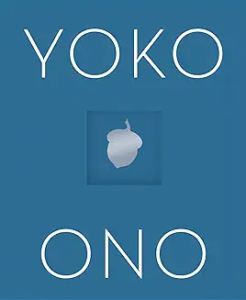Acorn by Yoko Ono 2013
Yoko Ono was one of the most recognizable iconic images of the 1960’s and ’70’s. Nearly always portrayed with John Lennon either in bed or in full frontal nudity, she was the classic iconoclast, known more for her looks than her deeds.
A wonderful one-woman exhibition of her art last year at the Tate Modern in London when she was 90 changed my perceptions of her. The work was brilliant, creative, beautiful and ugly at the same time, and most of all, totally engaging. From video to music, from small beautiful objects to a ‘wish tree’ where visitors could write wishes on white tags and hang them on the tree, this was a remarkable exhibition. Ono’s marriage to Lennon has overshadowed her own contributions to music and art originally as a member of Fluxus in New York and over the last 50 years on her own.
She has written a number of books, and this one is unusual and thought-provoking. A small volume measuring 5 inches x 6 inches with a lovely purple/blue heavy cover and lacking in page numbers, the book reads like a series of requests or suggestions from Ono to the reader. Divided into 13 sections, called ‘Pieces’, they include sky, earth, city, watch, room, cleaning, sound, dance, life, wish, questionnaire, quiz, and conclude with two pieces labelled Revelations and End Piece. In each set, Ono suggests an action and provides her interpretation of what that action will result in for the reader. In an example that is dear to my own heart, Sky Piece III states “Imagine a cloud/slowly/going across the sky/and back. Send a postcard to your friend.” Another piece labelled Cleaning Piece III reads “Try to say nothing negative about anybody./ a) for three days/ b) for forty-five days/ c) for three months/ See what happens to your life.” Each of these tiny blank verse poems is accompanied on the opposite page by an image in black and white dots. In the book’s introduction, Ono writes “I added my dot drawings to give you further brainwork.”
This is a charming, thought-provoking, visually fascinating little book. It reveals Ono’s commitment to beauty, peace, and a close examination of the earth and universe in which we live. Being kind to oneself as well as to others is the theme embedded in these ‘pieces’. In the final piece, “Revelations” Ono blesses the reader in separate stanzas for his/her anger, sorrow, greed, jealousy, fear, lack of direction, seeing evil, feeling no love and then indicates how each of these negative elements can be transformed into positive ones, e.g. fear into flexibility, anger into versatility, and so on. She concludes that piece with these words: “The world has all that you need/And you have the power/to attract what you wish./Wish for health,. wish for joy/Remember you are loved.”
At 91, Ono continues to make art, write, and speak to the power of love to heal our world. This book is a fine introduction to her work.



